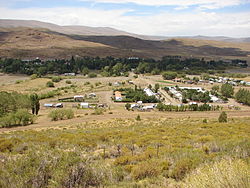El Huecú
El Huecú | |
|---|---|
 El Huecú as of 2008 | |
| Coordinates: 37°37′S 70°35′W / 37.617°S 70.583°W | |
| Country | |
| Province | Neuquén Province |
| Department | Ñorquín Department |
| Founded | October 20, 1915 |
| Government | |
| • Mayor | Rodolfo Canini |
| Elevation | 1,569 m (5,148 ft) |
| Population | |
| • Total | 1,391 |
| CPA Base | Q 8349 |
| Area code | +54 02948 |
| Climate | Csb |
El Huecú is a third category municipality and capital of the Ñorquín Department, on the Provincial Road 4, in the north of the Argentine province Neuquén.
It was founded in 1940. Because of the importance of the goat breeding on its economy, it annually hosts the Festival of the Shepherd.
History
The former city of Ñorquín was initially the capital of the department and had a population of more than one thousand inhabitants. The first municipal election took place in 1886.[1] Its population gradually moved to El Huecú due that the previous capital was located on private property.[2]
The establishment of El Huecú was authorized on September 2, 1938 by the national decree 11392. In 1940, the Argentine Executive Power designated El Huecú as the new department capital, but it was officially founded on February 1, 1940. The municipality was built in 1973 and it received its third-category status, which still holds, on 11 November 1976.[3]
El Huecú is one of the northern Neuquen's municipalities that has a participative budget. Since 2004, the Mapuche people are recognized as original inhabitants of the region. In 2003, the lonko Carlos Maripal became the first non-elected member of the Mapuche community in the province to occupy a position at a local legislature.[4]
Origin of the name
The municipality's name comes from the Mapudungun, meaning Genious of the evil. The word was used by the Mapuche people to refer to the bunchgrass Vulpia octoflora.[3]
Geography
El Huecú is the capital of the Ñorquin Department, in the northwest of the Province. It is located 370 kilometers from Neuquén and 90 kilometers from Chos Malal, on the Provincial Road 4.[5] It is surrounded by the Mandolegue the Trocomán ranges.[6] Its elevation is 1,200 m above sea level.[1]
Demographics
In 2016, it was estimated that 2,194 people lived in the area.[7] As of the 2010 Argentine census, the population of El Huecú was 1,391, showing almost no change in comparison to 1,399 recorded in 2001.[8] In 1970 the population was 255 people. The next censuses showed a total of 743 (1980) and 1,149 (1991) inhabitants, respectively.[9]
Festival of the Shepherd
The goat breeding represents a major role in the local economy.[2] El Huecú annually hosts the Festivity of the Shepherd (Fiesta del Criancero in Spanish) in December, revering the local goat shepherds that still practice the transhumance.[10]
References
- ^ a b "Febrero, un mes repleto de celebraciones para la Provincia". La Mañana Neuquén (in Spanish). 2 February 2011. Archived from the original on 2 October 2011. Retrieved 4 August 2011.
- ^ a b "El Huecú's page on Neuquén province's tourist site". Neuquén province's tourist site (in Spanish). Neuquén.com SA. Archived from the original on 27 November 2010. Retrieved 13 July 2011.
- ^ a b "El Huecú celebrates its 70th anniversary". Neuquén's Under-secretariat for Public Information (in Spanish). Neuquén Provincial Government. 18 February 2010. Retrieved 13 July 2011.
- ^ "The councilman who makes history". La Mañana Neuquén (in Spanish). La Mañana Neuquén's Site. 7 December 2007. Retrieved 13 July 2011.
- ^ "How to get to El Huecú's". Argentina's Official Tourist Site (in Spanish). ArgentinaTurismo.com.ar. Retrieved 13 July 2011.
- ^ "El Huecú's page on Argentina's Official Tourist Site". Argentina's Official Tourist Site (in Spanish). ArgentinaTurismo.com.ar. Retrieved 13 July 2011.
- ^ "Información Estadística y Epimediológica Neuquén - Libro de Indicadores" (PDF). Ministry of Health of the Province of Neuquén (in Spanish). Government of the Province of Neuquén. Retrieved 27 May 2021.
- ^ "El Cholar, El Huecú y Tauimilán". Neuquén Province's tourist site (in Spanish). NeuquenTur S.E. Retrieved 27 May 2021.
{{cite web}}: Cite has empty unknown parameter:|1=(help) - ^ "Población total por censo y tasa media anual de crecimiento según municipio y categoría del mismo. Censos 1970, 1980, 1991 y 2001" (PDF). Neuquén province's Official Website (in Spanish). Government of the Province of Neuquén. 2006. Retrieved 27 May 2021.
- ^ "Neuquén's tourist site". Calendar of local popular and religious festivals (in Spanish). NeuquenTur S.E. Archived from the original on 27 March 2012. Retrieved 14 July 2011.


